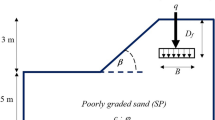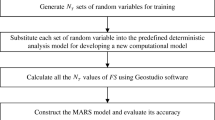Abstract
It is indicated in the literature that current empirical formulas are not able to predict the damage level very accurately for the conventional rubble-mound structures, leading to the unnecessary increase in the construction cost. Therefore, it is imperative to be able to accurately predict the damage level. This study presents a multivariate adaptive regression splines (MARS) approach for predicting the damage level of armor blocks of breakwaters. This technique presents a flexible regression by the use of separate regression slopes in distinct intervals of the independent variable. An experimental dataset of Van der Meer (VDM) containing small- and large-scale tests are employed. Two MARS models, one is for taking into account the main effects and the other for considering two-way interactions, and a multiple stepwise regression model is constructed and compared with each other and widely used empirical formulae of VDM. In the model constructed, variables of permeability, cot α, number of waves, stability number, ξm, ξm/ξmc are found to be most effective ones. The relative error, Nash–Sutcliffe efficiency, mean absolute error, percent bias, and adjusted R2 statistics are used for evaluating the accuracy of models. The comparison results indicate that the MARS model with two-way interactions performs better than the other models in the damage level estimation for the particular datasets employed in this study.





Similar content being viewed by others
References
Van der Meer JW (1988) Rock slopes and gravel beaches under wave attack. Ph.D. thesis, Delft University of Technology, Delft, The Netherlands
Kaku S, Kobayashi N, Ryu CR (1991) Design formulas for hydraulic stability of rock slopes under irregular wave attack. In: Proceedings of 38th Japanese conference coastal engineering, Tokyo, Japan, pp. 661–665
Mase H, Sakamoto M, Sakai T (1995) Neural network for stability analysis of rubble-mound breakwaters. J Waterw Port Coast Ocean Eng 121(6):294–299
Melby JA (1999) Damage progression on rubble-mound breakwaters (No. WES/TR/CHL-99-17). Army Engıneer Waterways Experıment Statıon Vıcksburg Ms Coastal and Hydraulıcs Lab.
Alreja J, Parab S, Mathur S, Samui P (2015) Estimating hysteretic energy demand in steel moment resisting frames using multivariate adaptive regression spline and least square support vector machine. Ain Shams Eng J 6(2):449–455
Chang LY (2014) Analysis of bilateral air passenger flows: a non-parametric multivariate adaptive regression spline approach. J Air Transp Manage 34:123–130
Chau KW, Wu CL (2010) A hybrid model coupled with singular spectrum analysis for daily rainfall prediction. J Hydroinform 12(4):458–473
Cheng MY, Cao MT (2014) Accurately predicting building energy performance using evolutionary multivariate adaptive regression splines. Appl Soft Comput 22:178–188
Haghiabi AH (2016) Prediction of river pipeline scour depth using multivariate adaptive regression splines. J Pipeline Syst Eng Pract 8(1):04016015
Wang WC, Chau KW, Xu DM, Chen XY (2015) Improving forecasting accuracy of annual runoff time series using ARIMA based on EEMD decomposition. Water Resour Manage 29(8):2655
Wu CL, Chau KW, Fan C (2010) Prediction of rainfall time series using modular artificial neural networks coupled with data-preprocessing techniques. J Hydrol 389(1):146–167
Zhang J, Chau KW (2009) Multilayer ensemble pruning via novel multi-sub-swarm particle swarm optimization. J UCS 15(4):840–858
Thompson DM, Shuttler RM (1976) Design of rip-rap slope protection against wind waves. Report no. 61, CIRIA, London, UK
BS 6349 2000 British Standards. Maritime structures—part 1: code of practice for general criteria. ISBN 0 580 33169 5
CEM (2002) Coastal engineering manual. U.S. Army Corps of Engineers, Engineer Manual 1110-2-1100, Washington DC
Rock Manual (2007) The rock manual; the use of rock in hydraulic engineering. CIRIA-CUR, Publication C683, ISBN 978-0-86017-683-1 and 5
Okcu D, Pektaş AO, Uyumaz A (2016) Creating a non-linear total sediment load formula using polynomial best subset regression model. J Hydrol. doi:10.1016/j.jhydrol.2016.04.069
Friedman J (1991) Multivariate adaptive regression splines. Ann Stat 19:1–141
Legates DR, McCabe GJ Jr (1999) Evaluating the use of “goodness-of-fit” measures in hydrologic and hydroclimatic model validation. Water Resour Res 35(1):233–241
Krause P, Boyle DP, Bäse F (2005) Comparison of different efficiency criteria for hydrological model assessment. Adv Geosci 5:89–97
Gupta HV, Sorooshian S, Yapo PO (1999) Status of automatic calibration for hydrologic models: comparison with multilevel expert calibration. J Hydrol Eng 4(2):135–143
Moriasi DN, Arnold JG, Van Liew MW, Bingner RL, Harmel RD, Veith TL (2007) Model evaluation guidelines for systematic quantification of accuracy in watershed simulations. Trans ASABE 50(3):885–900
Author information
Authors and Affiliations
Corresponding author
Ethics declarations
Conflict of interest
We declare no conflict of interest with anyone.
Rights and permissions
About this article
Cite this article
Erdik, T., Pektas, A.O. Rock slope damage level prediction by using multivariate adaptive regression splines (MARS). Neural Comput & Applic 31, 2269–2278 (2019). https://doi.org/10.1007/s00521-017-3186-2
Received:
Accepted:
Published:
Issue Date:
DOI: https://doi.org/10.1007/s00521-017-3186-2




